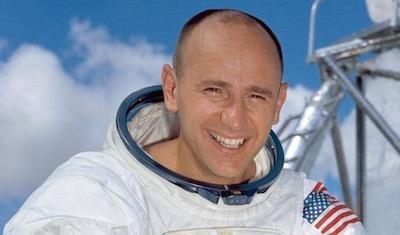Had Fallen Ill Only Two Weeks Ago While Traveling
Apollo and Skylab astronaut Alan Bean, the fourth human to walk on the moon and an accomplished artist, has Gone West.

Bean, 86, passed away May 26, at Houston Methodist Hospital in Houston, Texas. His death followed his suddenly falling ill while on travel in Fort Wayne, Indiana two weeks before.
“Alan was the strongest and kindest man I ever knew. He was the love of my life and I miss him dearly,” said Leslie Bean, Alan Bean’s wife of 40 years. “A native Texan, Alan died peacefully in Houston surrounded by those who loved him.”
A test pilot in the U.S. Navy, Bean was one of 14 trainees selected by NASA for its third group of astronauts in October 1963. He flew twice into space, first as the lunar module pilot on Apollo 12, the second moon landing mission, in November 1969, and then as commander of the second crewed flight to the United States’ first space station, Skylab, in July 1973.
“Alan and I have been best friends for 55 years — ever since the day we became astronauts,” said Walt Cunningham, who flew on Apollo 7. “When I became head of the Skylab Branch of the Astronaut Office, we worked together and Alan eventually commanded the second Skylab mission.”
“We have never lived more than a couple of miles apart, even after we left NASA. And for years, Alan and I never missed a month where we did not have a cheeseburger together at Miller’s Café in Houston. We are accustomed to losing friends in our business but this is a tough one,” said Cunningham.
On Nov. 19, 1969, Bean, together with Apollo 12 commander Charles “Pete” Conrad, landed on the Ocean of Storms and became the fourth human to walk on the moon. During two moonwalks Bean helped deploy several surface experiments and installed the first nuclear-powered generator station on the moon to provide the power source. He and Conrad inspected a robotic Surveyor spacecraft and collected 75 pounds (34 kilograms) of rocks and lunar soil for study back on Earth.
“Alan and Pete were extremely engaged in the planning for their exploration of the Surveyor III landing site in the Ocean of Storms and, particularly, in the enhanced field training activity that came with the success of Apollo 11. This commitment paid off with Alan's and Pete's collection of a fantastic suite of lunar samples, a scientific gift that keeps on giving today and in the future,” said Harrison Schmitt, Apollo 17 lunar module pilot and the only geologist to walk on the moon. “Their description of bright green concentrations of olivine (peridot) as ‘ginger ale bottle glass,’ however, gave geologists in Mission Control all a big laugh, as we knew exactly what they had discovered.”
“When Alan's third career as the artist of Apollo moved forward, he would call me to ask about some detail about lunar soil, color or equipment he wanted to have represented exactly in a painting. Other times, he wanted to discuss items in the description he was writing to go with a painting. His enthusiasm about space and art never waned. Alan Bean is one of the great renaissance men of his generation — engineer, fighter pilot, astronaut and artist,” said Schmitt.
Four years after Apollo 12, Bean commanded the second crew to live and work on board the Skylab orbital workshop. During the then-record-setting 59-day, 24.4 million-mile flight, Bean and his two crewmates generated 18 miles of computer tape during surveys of Earth’s resources and 76,000 photographs of the Sun to help scientists better understand its effects on the solar system.
In total, Bean logged 69 days, 15 hours and 45 minutes in space, including 31 hours and 31 minutes on the moon’s surface.
Bean retired from the Navy in 1975 and NASA in 1981. In the four decades since, he devoted his time to creating an artistic record of humanity’s first exploration of another world. His Apollo-themed paintings featured canvases textured with lunar boot prints and were made using acrylics embedded with small pieces of his moon dust-stained mission patches.
“Alan Bean was the most extraordinary person I ever met,” said astronaut Mike Massimino, who flew on two space shuttle missions to service the Hubble Space Telescope. “He was a one of a kind combination of technical achievement as an astronaut and artistic achievement as a painter.”
“But what was truly extraordinary was his deep caring for others and his willingness to inspire and teach by sharing his personal journey so openly. Anyone who had the opportunity to know Alan was a better person for it, and we were better astronauts by following his example. I am so grateful he was my mentor and friend, and I will miss him terribly. He was a great man and this is a great loss,” Massimino said.
Born March 15, 1932, in Wheeler, Texas, Bean received a Bachelor of Science degree in aeronautical engineering from the University of Texas in 1955. He attended the Navy Test Pilot School and accumulated more than 5,500 hours of flying time in 27 different types of aircraft.
He is survived by his wife Leslie, a sister Paula Stott, and two children from a prior marriage, a daughter Amy Sue and son Clay.
(Image provided with NASA news release)
 ANN's Daily Aero-Term (04.26.24): DETRESFA (Distress Phrase)
ANN's Daily Aero-Term (04.26.24): DETRESFA (Distress Phrase) ANN's Daily Aero-Linx (04.26.24)
ANN's Daily Aero-Linx (04.26.24) Airborne 04.22.24: Rotor X Worsens, Airport Fees 4 FNB?, USMC Drone Pilot
Airborne 04.22.24: Rotor X Worsens, Airport Fees 4 FNB?, USMC Drone Pilot Airborne 04.24.24: INTEGRAL E, Elixir USA, M700 RVSM
Airborne 04.24.24: INTEGRAL E, Elixir USA, M700 RVSM Airborne-NextGen 04.23.24: UAVOS UVH 170, magni650 Engine, World eVTOL Directory
Airborne-NextGen 04.23.24: UAVOS UVH 170, magni650 Engine, World eVTOL Directory



